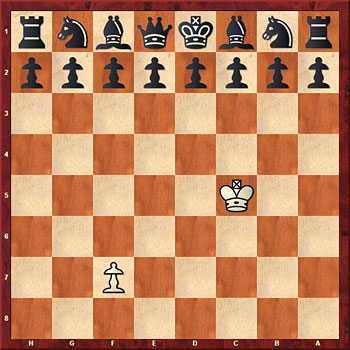


Pal Benko sent us his helpmate and stalemate problems explicitly as April 1st entertainment. The were all correct and very satisfying to solve (as helpmates usually are). But how many of you noticed that for the last two you had to reverse the board – as the coordinates quite clearly show. So, for those who didn't notice and found the solutions trivially easy, here's a chance to solve the problems with White moving down the board. The solutions will be published next week.

Black to play – help-stalemate in five moves (White moves downwards!)
Sergey Karjakin, the winner of the 2016 Candidates tournament in Moscow, did indeed receive a real BMW i8 sports car. It is his to drive around for a full month, as clearly stated. The little model i8 was just a symbolic gift at the closing ceremony.

The picture we used showed Sergey Karjakin holding a model BMW i8 – our intention was to have as many readers as possible think: oh, April Fool, all he got was a toy BMW. We transcribed the speech of Development Director of the BMW Group in Russia, Hans de Visser, at the closing ceremony, but expediently left out the bit where it became clear that Sergey would be driving away with a real BMW parked in front of the venue. The omitted passage is given in italics.
Chess is one of the most intellectual games in the world, and our brand, BMW, is known all around the world for our intellectual engineering and our innovations. So for us it is a perfect match. On behalf of BMW Russia I am happy to congratulate Sergey for winning the tournament. For us it was not difficult to find the right award for this great achievement. We thought about driving our most progressive sports car in the world: the BMW i8. Most of you have seen the real car in front of the door, but now you know who is driving away tonight with this car. It's Sergey. Here a small handover of a miniature. So, Sergey, a car that drives up to 250 kilometers an hour, from zero to one hundred in four seconds, carbon fibre body and a fuel consumption of only 2.1 liters for 100 kilometers [translates to 112 miles per gallon]. I think perfec figures. What do you think? [Sergey: "That's my dream"]
So Sergey can actually drive around in his i8, and we suggested he race it against Magnus Carlsen's Tesla. Here's what a drag race from stop would look like, and here a race from roll. Hope the World Championship match in New York is closer.
Addendum: watch a Tesla Model S drag race a Boeing 737
The real April Fool's joke was buried in the Hillary seeks Irina Krush story: the Donald Trump mate-in-four and the narrative around it was cooked up by two ChessBase editors who will remain unnamed – what if Trump sues? The story was surely silly enough, and most of our readers recognizes the satire it contained.
Donald Trump, Chess Life 1968

White to play and mate in four moves – a valuable allumwandlung
We are close to abandoning our April Fool's pranks in the future. Over the years – over close to two decades, actually – it has become progressively more difficult for us to construct stories that do what they are supposed to do: fool as many people as possible and be entertaining. Of course it is trivially easy to fulfil the first criterion: "ChessBase to manufacture bottled drinks" is something nobody can easily check. But it is not funny.
We believe we have succeeded in the second criterion fairly well in the past: we produced a gaudy, blinking news page (for a full day) in 2011, and told of the discovery that Matt Damon was the second cousin of Magnus Carlsen in the year before that. However, the task of actually fooling people has become progressively more difficult. On April 1st armed insurgents, equipped with advanced Google searches and massive forum discussions, attack our news page and post forum messages telling everybody what the April joke was and how easily they had recognised it.
So we started hiding the prank behind fake jokes, i.e. publishing reports that sounded fairly outrageous but were perfectly true. Take for instance April 1st 2010: we started with an article telling about how grandmasters were worried about the Large Hadron Collider at CERN in Switzerland/France. Later in the day we reported that authorities in Reykjavik had decided to exhume Fischer body to extract DNA in a paternity suit. Both reports were perfectly true. Then finally the Carlsen-Damon report mentioned above. It was interesting for us to see the successive tsunamis of letters strike our mail box after each report appeared on the news page.
But things kept getting progressively more difficult, as the Internet detectives arm themselves with ever more powerful tools. So we had to increase our efforts to hide the pranks. In 2012, for instance, we published three fake April Fool reports before publishing the real joke – which was about Rybka author Vasik Rajlich busting the King's Gambit in a project that involved 3000 processor cores, running for over four months, exhaustively analysing all lines that follow after 1.e4 e5 2.f4 exf4. This appeared on April 2nd, which many readers called unfair. But we claimed that was not the case: it was posted just before midnight April 1st – in Pago Pago, and was intended to fool the vast number of Pago Pagoians who visit our news page.
However, the report on the busting of the King's Gambit got us in a bit of trouble: a few hours after it had appeared we got a call from a journalist working for the New York Times who wanted to do a story on Rajlich's remarkable achievement. When we told him it was an April Fool's joke he said: "Oh shoot! I got up at five this morning to come to the NYT office to write the report." Our confession that it had been a joke appeared a few hours later.
Another prank that got us into a bit of trouble was one published on April 1st 2002. This was essentially the gist:
Bobby Fischer has already introduced two important innovations that have received a larger or smaller degree of acceptance by the chess community. First came the "Fischer clock", which adds a small time increment after every move, thereby alleviating the brutal time trouble some players tend to get into. Then came "Fischer Random Chess", which scrambles the position of the pieces at the beginning of the game. This is designed to eliminate the very extensive openings preparation that is encountered in top-level chess today.
Now Fischer has turned his sights on what he believes is an unbearable preponderance of tactics in chess. His declared intention is to return the game to its origins and not allow the strategic spirit to be destroyed by "cheapo shots constantly fired by younger players." To this end he has submitted a rule modification, which FIDE is currently considering and will present to the delegates at its next general council meeting during the Dubai Grand Prix.
Fischer's proposal adds one rule to section 4.1-4.7 ("The act of moving the pieces") in FIDE's "Laws of Chess". The new article 4.8 states that: "After a player has registered a move by his opponent he may, as part of his next move, either execute a move in the form stipulated by the rules 4.1-4.7 given above; or instead he may execute the opponent's and his own previous moves in reverse order, replacing any captured pieces onto their original squares, and then execute an alternative move, in accordance with the rules 4.1-4.7 given above."
The new "Fischer move" (which is also referred to as a "retractor") does not change the original flavour of the game – in fact many believe it actually reflects it more completely than the rules practised in tournaments today. The new rule has been extensively tested in informal play, where the advantages of the system are immediately obvious. Games are no longer decided by simple tactical strokes, the outcome depends much more on a painstaking exploratory strategy of "trial and error". The only disadvantage is that games may sometimes last a little longer, especially when a number of Fischer moves are executed.
The new Fischer move rule also provides an interesting solution to the problem of chess playing computers, which are the sharpest tactical entities on the planet. Our own experiments have shown that players who were scoring zero points against the 2750-rated Fritz program were actually winning some of their games when allowed to make extensive use of retractor moves.
FIDE has stressed that a decision in Dubai to adopt the Fischer move rule would not mean that it would be immediately implemented in all tournaments organised or sanctioned by the world chess organisation. "We anticipate that it will take a number of years before the new rule is universally accepted," said a ranking FIDE official. "Until then both forms of chess can coexist."
Many players are very enthusiastic about Fischer move games. "Retractor games remove the unnecessary tension of ruining your game with stupid blunders," said one leading grandmaster. "I can be much more daring in my choice of moves." But Judit Polgar, the world's strongest female player, disagrees. "I have my doubts about this new rule, maybe because I am not very good at it. I lost an retractor game in an important tournament once."
All very cute and funny. But unfortunately we soon got a press release from an Asian chess federation (which will remain unnamed) that said they had formed a special committee to protest Fischer's proposal and urge FIDE not to consider it.
In the following year a number of April 1st articles brought protest and animosity, or backfired the way this year's Google April Fool's prank did (the search giant realized: it's not okay to prank 900 million people). And it has become too easy to detect the joke on our news page (damn you, Google!). For this reason we will probably abandon the tradition in the future – really, not as we announced in this April 1st story.
